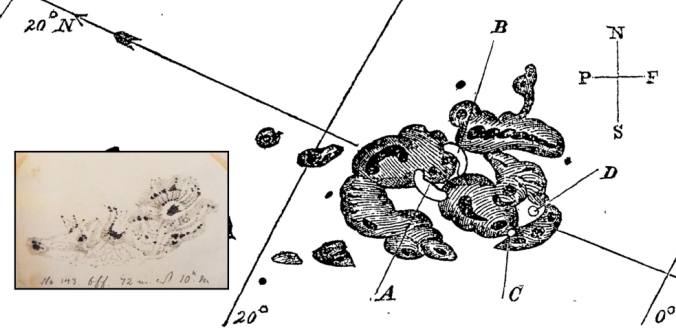Sept. 1, 2020: On Sept. 1st, 1859, the most ferocious solar storm in recorded history engulfed our planet. “The Carrington Event,” named after British scientist Richard Carrington who witnessed the instigating solar flare, sparked auroras from Cuba to Hawaii, set fire to telegraph stations, and wrote itself into history books as the Biggest. Solar. Storm. Ever.
But, sometimes, what you read in history books is wrong.
“The Carrington Event was not unique,” says Hisashi Hayakawa of Japan’s Nagoya University, whose recent study of solar storms has uncovered other events of comparable intensity. “While the Carrington Event has long been considered a once‐in‐a‐century catastrophe, historical observations warn us that this may be something that occurs much more frequently.”

Drawings of the Carrington sunspot by Richard Carrington on Sept. 1, 1859, and (inset) Heinrich Schwabe on Aug. 27, 1859. [Ref]
Many previous studies of solar superstorms leaned heavily on Western Hemisphere accounts, omitting data from the Eastern Hemisphere. This skewed perceptions of the Carrington Event, highlighting its importance while causing other superstorms to be overlooked.
A good example is the great storm of mid-September 1770, when extremely bright red auroras blanketed Japan and parts of China. Captain Cook himself saw the display from near Timor Island, south of Indonesia. Hayakawa and colleagues recently found drawings of the instigating sunspot, and it is twice the size of the Carrington sunspot group. Paintings, dairy entries, and other newfound records, especially from China, depict some of the lowest-latitude auroras ever, spread over a period of 9 days.

An eyewitness sketch of red auroras over Japan in mid-September 1770. [Ref]
Hayakawa’s team has delved into the history of other storms as well, examining Japanese diaries, Chinese and Korean government records, archives of the Russian Central Observatory, and log-books from ships at sea–all helping to form a more complete picture of events.
They found that superstorms in February 1872 and May 1921 were also comparable to the Carrington Event, with similar magnetic amplitudes and widespread auroras. Two more storms are nipping at Carrington’s heels: The Quebec Blackout of March 13, 1989, and an unnamed storm on Sept. 25, 1909, were only a factor of ~2 less intense. (Check Table 1 of Hayakawa et al‘s 2019 paper for details.)

Oriental reports of a giant naked-eye sunspot group (left) and auroras (right) in Feb. 1872. [Ref]
Are we overdue for another Carrington Event? Maybe. In fact, we might have just missed one.
In July 2012, NASA and European spacecraft watched an extreme solar storm erupt from the sun and narrowly miss Earth. “If it had hit, we would still be picking up the pieces,” announced Daniel Baker of the University of Colorado at a NOAA Space Weather Workshop 2 years later. “It might have been stronger than the Carrington Event itself.”
History books, let the re-write begin.
Pingback: A Warning from History: The Carrington Event was not Unique - by Dr Tony Phillips - Electroverse
We may all live in an electromagnetic Universe, but yes I agree completely with this article, so yes eternal vigilance is correct not wrong. Thank you.
LikeLike
MY INTUITIVE GUIDANCE TELLS ME (AND IT IS USUALLY RIGHT) THAT WE WILL SEE A MAJOR CME IN 2023 OR 2024.
AND, BECAUSE OUR GOVERNMENT HAS DONE NOTHING TO PREPARE, IT WILL BE DEVASTATING IF WE ARE IN LINE. PRAY NOT, BUT THAT IS ALL WE CAN DO.
LikeLike
Pingback: Un avertissement de l’histoire : l’événement solaire de Carrington en 1859 n’était pas unique | Terra Projects
We are totally unprepared for another CME of Carrington strength. Thing is, with the Earth’s magnetic poles shifting as they are, the magnetic shield is weakening, and in turn, it decreases the ability to deflect the effects of previously weaker CMEs. This means our vulnerability to an electrical grid collapse increases with time. The article mentions some of the consequences which would occur once a grid collapse happens, but the unmentioned additional effects are orders of magnitude worse for humanity. The entire “just in time” supply chain would utterly collapse. Food shortages would appear within days. Modern trucks, cars, ships, and planes, would have their computers and electrical systems fried, making them useless. The ability to distill, transport, let alone pump fuel, will be extremely limited at best. The grid itself could be down for months, even years. Essential transformers, damaged beyond repair, have no replacements. Worse, they are no longer even built in North America. On top of all that, without grid power, only emergency generators will be available to power the spent nuclear fuel rod storage pool facilities (there are 90+ nuclear power plants and storage pools just within the US alone) in order to keep those rods submerged under fresh water, But they only have a finite amount of fuel. If that fuel supply is disrupted, or a mechanical problem occurs, the circulation system will fail. Once those rods come in contact with air, they will spontaneously combust and burn uncontrollably. The cumulative amount of radiological contamination that would be released from various facilities worldwide, is, by itself, an extinction level event. These are only some of the problems. I won’t go into the societal ones. There has been extensive studies conducted, even at the Congressional level, and all the consequences are known. It is nothing less than criminal complacency, and dereliction of duty, that this vulnerability is allowed to continue; especially when known solutions for hardening the grid are available today.
LikeLiked by 1 person
Pingback: A “Perfect Coronal Mass Ejection” Could Be a Nightmare – Organisasi Amatir Radio Indonesia
Pingback: Uranus in Gemini: Revolution in Communication and Transport – Jessica Davidson